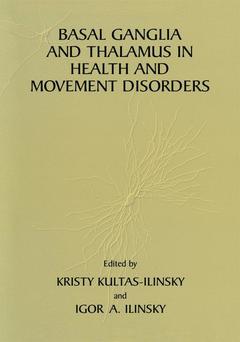Part I: Basal Ganglia Circuitry in Movement Disorders: Historical Perspective and Overview of the Current Status of the Field. What We Know and What We Have Left to Learn; A.B. Young, J.B. Penney. Basal Ganglia Circuits in Movement and Movement Disorders; T. Wichmann, M. DeLong. Part II: Anatomical and Functional Organization of Basal Ganglia and Motor Thalamic Circuits. Microcircuits of the Striatum; J.P. Bolam, M.D. Bevan. Local and Efferent Neurons and Intrinsic Modular Arrangement of the Human Striatum; T. Leontovich. Efferent Connections of the Human Striatum and Pallidum: A Nauta Degeneration Study; A. Morel, et al. Cognitive Aspects of the Motor Function of the Striatum; B.F. Tolkunov, et al. Neuroanatomical Organization and Connections of the Motor Thalamus in Primates; I.A. Ilinsky, K. Kultas-Ilinsky. Pallidal and Cortical Determinants of Thalamic Activity; M.E. Anderson, et al. Physiological Evidence for Spinal Cord Input to the Motor Thalamus; R. Mackel. Part III: Neurotransmitters, Receptors and Their Role in Motor Behavior. Chemical Anatomy and Synaptic Connectivity of the Globus Pallidus and Subthalamic Nucleus; Y. Smith, et al. Effects of Dopamine Receptor Stimulation on Basal Ganglia Activity; J.R. Walters, et al. Physiological Roles of Multiple Metabotropic Glutamate Receptor Subtypes in the Rat Basal Ganglia; P.J. Conn, et al. Muscarinic Receptors of the Dorsal Striatum: Role in Regulation of Motor Behavior; K. Shapovalova. Part IV: Movement and Sleep Disorders as Related to Basal Ganglia-Thalamic Circuits. Functional Organization of Brainstem-Basal Ganglia Interactions as Viewed From the Pedunculopontine Region; G.L. Keating, D.B. Rye. Fatal Familial Insomnia: A Disease Model Emphasizing the Role of the Thalamus in the Regulation of the Sleep-Wake Cycle and Other Circadian Rhythms; P. Avoni, et al. Part V: Plasticity in Movement Disorders. Plasticity and Basal Ganglia Disorders; M. Hallet. Mechanisms of Subthalamic Dysfunction in Parkinson's Disease; M.-F. Chesselet, et al. Neurotransmitters and Receptors in the Primate Motor Thalamus and Potential for Plasticity; K. Kultas-Ilinsky, I.A. Ilinsky. Microelectrode Studies of Basal Ganglia and VA, VL and VP Thalamus in Patients with Dystonia: Dystonia-Related Activity and Somatic Sensory Reorganization; F.A. Lenz, et al. Part VI: Neuronal Activity in Movement Disorders. Physiology of Globus Pallidus Neurons in Movement Disorders; M. Filion. Physiology of Subthalmic Nucleus Neurons in Animal Models of Parkinson's Disease; A. Benazzouz, et al. The Motor Thalamus: Alteration of Neuronal Activity in the Parkinsonian State; C. Elder, J. Vitek. Neuronal Activity In Motor Thalamus of Parkinson's Disease Patients; J.O. Dostrovsky, et al. Electrophysiological Insights Into the Motor Control System in Parkinsonism; S. Raeva. Behavior of Thalamic Neurons in the Movement Disorders - Tremor and Dystonia; C. Ohye, T. Shibazaki. The Motor Control Output Forming in Healthy Subjects and Parkinson's Disease Patients; S. Romanov, M.G. Pchelin. Part VII: Mechanisms and Efficiency of Novel Treatments for Movement Disorders. How Are We Inhibiting Functional Targets with High Frequency Stimulation? A.L. Benabid, et al. Is There a Single Best Surgical Procedure for the Alleviation of Parkinson's Disease? T. Aziz, et al. Thalamic Surgery for Tremor; A. Lozano, et al. What is the Influence of Subthalamic Nuc




